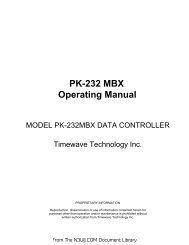DXE-RTR-1 Receive Antenna Interface for Transceivers - N3UJJ
DXE-RTR-1 Receive Antenna Interface for Transceivers - N3UJJ
DXE-RTR-1 Receive Antenna Interface for Transceivers - N3UJJ
- No tags were found...
You also want an ePaper? Increase the reach of your titles
YUMPU automatically turns print PDFs into web optimized ePapers that Google loves.
Diagram 9 demonstrates how the <strong>DXE</strong>-<strong>RTR</strong>-1 may be used in a classic T/R relay application with anadded bonus! The popular optional accessory <strong>for</strong> older receivers, the DX Engineering <strong>Receive</strong>Preamplifier model <strong>DXE</strong>-RPA-1, may be used safely, <strong>for</strong> improving reception on the transmit antenna,especially on higher frequencies. When the pre-amp is not required, it may be internally bypassed byremoving the DC power to it.Set the MAIN ON - RX ANT - MAIN ON toggle switch to the RX ANT (center) position to connectthe MAIN ANT to your receiver. When you key the transmitter, the <strong>DXE</strong>-<strong>RTR</strong>-1's automatic 4 mschangeover from receive to transmit switches the MAIN ANT to the transmitter. Manually switchingthe toggle switch to the MAIN ON (up) position connects the MAIN ANT to the transmitter, if desired<strong>for</strong> tune up operations. The power limit <strong>for</strong> the transmitter is 200 watts.The keying line from the transmitter* must be a Ground-On-Transmit type, as the <strong>DXE</strong>-<strong>RTR</strong>-1cannot accept any keying voltage. If the only keying line from the transmitter is a positive or negativevoltage type, then an Ameritron AMR-ARB-704 must be used in the transmitter keying line, asshown in Diagram 9. The ARB-704 will accept any keying voltage, 12 volts positive or negative andprovides the Ground-On-Transmit keying <strong>for</strong> the <strong>DXE</strong>-<strong>RTR</strong>-1.A muting line from the transmitter which may provide a ground <strong>for</strong> an older receiver, cannot beshared with the <strong>DXE</strong>-<strong>RTR</strong>-1, as many old receivers* require the grounding of a high voltage <strong>for</strong>muting.* Refer to your transmitter and receiver instruction manuals <strong>for</strong> keying line and muting linein<strong>for</strong>mation and requirements.In a special application with no receive antenna connections, Diagram 10 illustrates using the <strong>DXE</strong>-<strong>RTR</strong>-1 with an optional <strong>DXE</strong>-RSC-2 Two-Port Splitter/Combiner to allow one transmitting antennato be shared <strong>for</strong> simultaneous receive on two transceivers or with one transceiver and one receiver.The second radio is isolated from transmit energy by the <strong>DXE</strong>-<strong>RTR</strong>-1. Only the main transceivermay be used to transmit. The second transceiver that is connected to one of the <strong>DXE</strong>-RSC-2 outputsnust be transmit inhibited using either the radio's menu settings or power output controls set to zero toprevent system damage.Set the MAIN ON - RX ANT - MAIN ON toggle switch to the RX ANT (center) position to connectthe MAIN ANT to both radios <strong>for</strong> simultaneous reception. When you key the main transmitter, the<strong>DXE</strong>-<strong>RTR</strong>-1 automatically changes from receive on both radios to transmit on the MAIN ANT in only4 ms. The strong signal heard by the second radio is at a level that cannot damage it's front end.Manually switching the toggle switch to the MAIN ON (up) position connects the MAIN ANT to themain transceiver, if desired <strong>for</strong> tune up operations, or <strong>for</strong> normal operations without the second radio.The power limit <strong>for</strong> the transmitter is 200 watts.Diagram 11 demonstrates how the <strong>DXE</strong>-RSC-2 Two-Port Splitter/Combiners can be used to split theactive receive signal to the <strong>DXE</strong>-<strong>RTR</strong>-1 and a second radio. In most low band operations, the receiveantenna system will provide superior reception compared to the transmit antenna. An active receiveantenna offers the signal-to-noise advantage that allows weak DX signals to be heard which wouldotherwise be covered by noise when listening with the transmit antenna. The second transceiver thatis connected to one of the <strong>DXE</strong>-RSC-2 outputs must be transmit inhibited using either the radio'smenu settings or power output controls set to zero to prevent system damage.17From The <strong>N3UJJ</strong>.COM Document Library
















